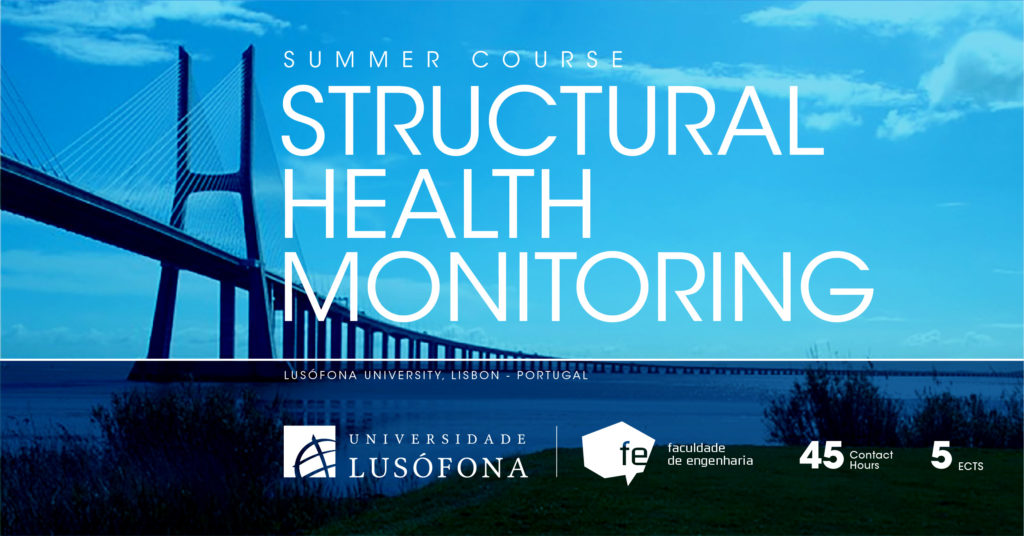Structural Health Monitoring

At our group, Structural Health Monitoring (SHM) has been proposed for damage identification in infrastructure (e.g., bridges) and road pavements, and more recently for climate change adaptation. Four main vectors have driven our research: system identification (e.g., dynamic field tests), machine learning, finite element modeling, and sensor node development.
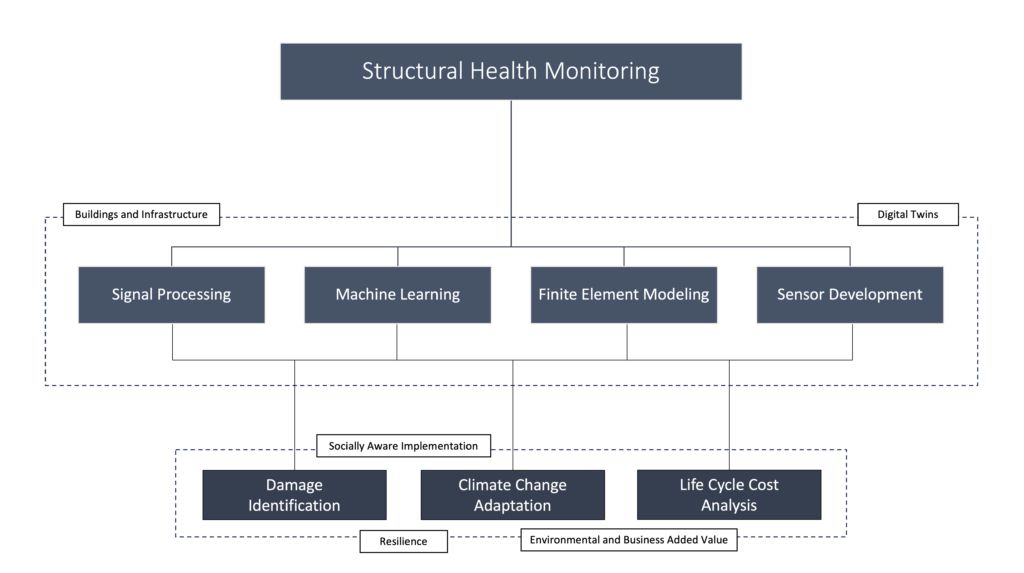
Advanced courses
This research topic has been lectured several times in the form of two courses.
SHM for damage identification
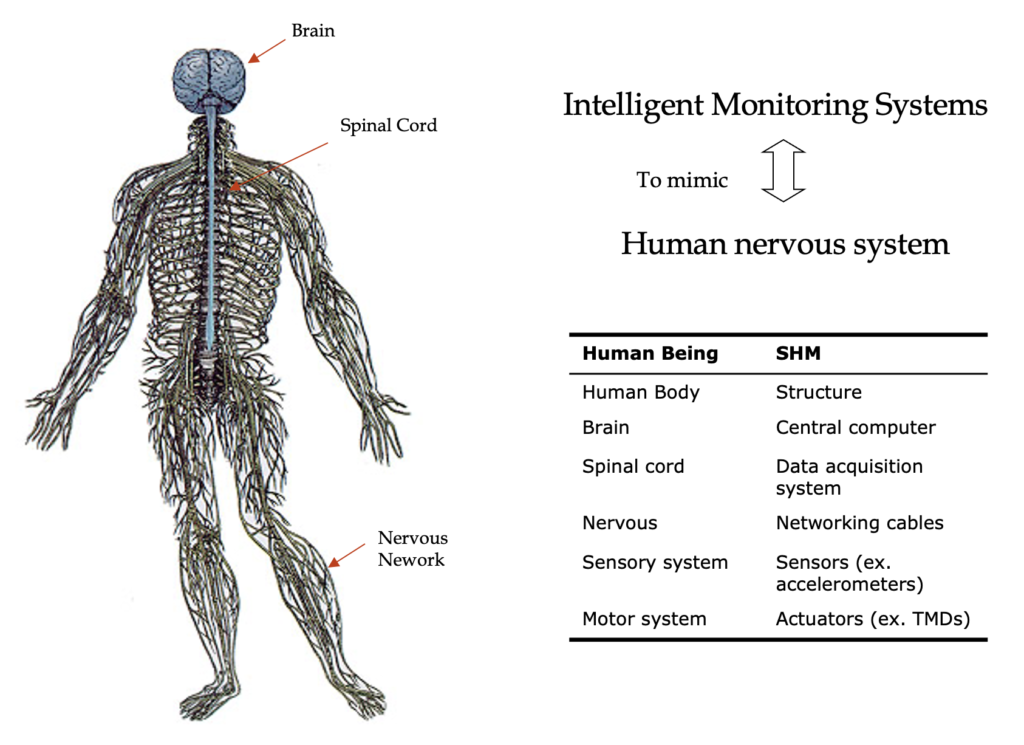
As discussed and reviewed in Figueiredo and Brownjohn (2022), the process of implementing a damage identification strategy for existing structures is often referred to as SHM. Under that definition, damage is normally defined as changes to the material and/or geometric properties of the structural system, including changes to the boundary conditions and system connectivity, which adversely affect the system’s current or future performance. The basic idea of SHM is to build up a system similar to the human nervous system, where the brain (computer) processes the information and determines actions (maintenance activities), and the nerves (sensors) feel the pain (damage). In this context, machine learning algorithms play an importante role, as they can learn from the experience, i.e. from monitoring data. Machine learning is the science of getting computers and algorithms to model the reality without knowing the physical laws of structures.
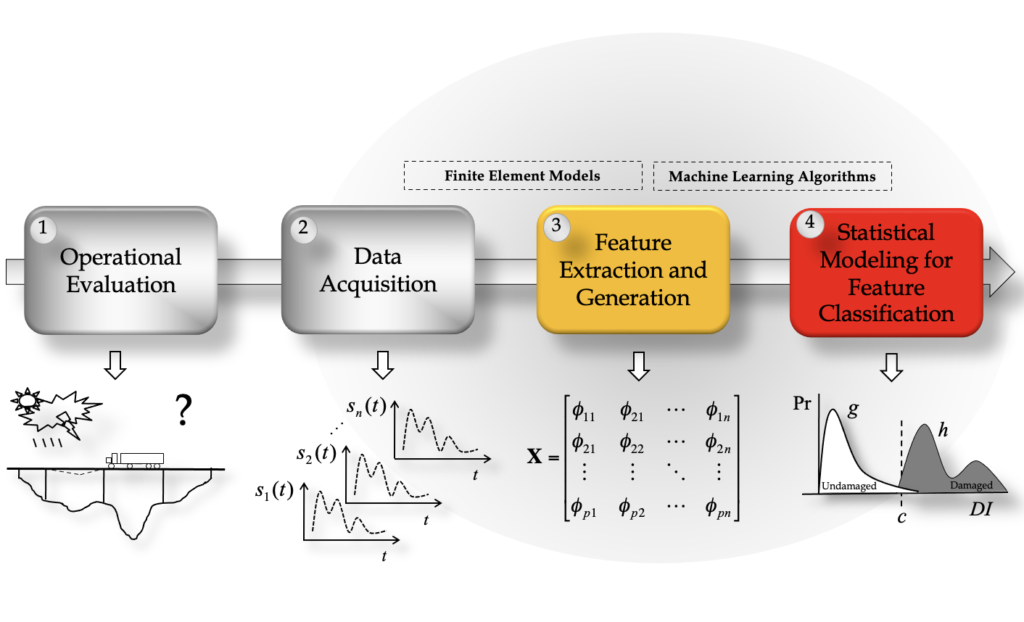
The SHM process can be posed in the context of a statistical pattern recognition (SPR) paradigm. The SPR paradigm is a way to simplify complex data and information into simple indices and graphical representations of better understanding to draw maintenance actions. In this paradigm, the SHM process can be broken down into four steps: Operational evaluation, Data acquisition, Feature extraction and generation, and Statistical modeling development for feature classification.

The damage identification should be as detailed as possible in order to describe the damage impact on the system. In a broad sense, developments on damage identification can be broken down into three areas, namely damage detection, damage diagnosis, and damage prognosis. Nonetheless, damage diagnosis can be subdivided in order to better characterize the damage in terms of location, type, and severity. Thus, even though the original guidelines of Rytter assumed four levels, the hierarchical structure of damage identification can be decomposed in five levels that answers the following questions: Is the damage present in the system (detection)? Where is the damage (localization)? What kind of damage is present (type)? What is the extent of damage (severity)? How much useful lifetime remains (prognosis)?
Bridge Management and Structural Condition Assessment of Bridges
The bridge management has been defined as a multidisciplinary field incorporating knowledge from structural engineering, information technology, and economics.
Improved and more continuous condition assessment of bridges has been demanded by our society to better face the challenges presented by aging civil infrastructure. Indeed, the recent collapses of the Hintze Ribeiro Bridge that killed 59 people, in Portugal, and the I-35W Bridge in the US, that killed 13 people, pointed out the need for new and more reliable tools to prevent such catastrophic events. Besides those events, the financial implications and potential impact through optimal bridge management are vast. For instance, the American Society of Civil Engineers reports the cost of eliminating all existing US bridge deficiencies at $850 billion. These values clearly show that planned bridge maintenance can lead to considerable savings.
In the last two decades, bridge condition assessment techniques have been developed independently based on two complementary approaches: Structural Health Monitoring (SHM) and Bridge Management Systems (BMSs). The SHM refers to the process of implementing monitoring systems to measure in real time the structural responses, in order to detect anomalies and/or damage at early stages. On the other hand, BMS is a visual inspection-based decision-support tool developed to analyze engineering and economic factors and to assist the authorities in determining how and when to make decisions regarding maintenance, repair, and rehabilitation of structures.
While the BMS has already been accepted by the bridge owners around the world, even though with inherent limitations posed by the visual inspections, the SHM is becoming increasingly appealing due to its potential ability to detect damage at early stages, with the consequent life-safety and economical benefits.
The author believes that, in an effort to create more robust bridge management, the SHM should be integrated into the BMS in a systematic way. Nowadays, there is a generalized consensus about this integration, but few real applications have been accomplished, mainly because of the lack of interaction between all the participants involved in the bridge management field.
App4SHM – Smartphone Application for SHM
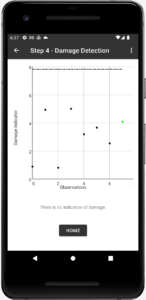
App4SHM is a smartphone application for structural health monitoring (SHM) of bridges or other civil structures to assess their condition after a catastrophic event or when required by authorities and stakeholders. The application interrogates the phone’s internal accelerometer to measure structural accelerations and applies artificial intelligence techniques to detect damage in almost real time.
How does it work? Do you want to know current state condition of your structure? Just place the smartphone on it, record an acceleration time series, and after few seconds you should be able to pick the natural frequencies. Is the structure damaged? After building a reference data set with multiple observations, you should be able to compare a new observation with past ones and raise a flag about the structure condition!
For more information: https://www.app4shm.com/ and Figueiredo et al. (2022).
Integration of physical modeling, monitoring and machine learning for SHM
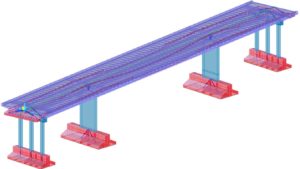
In the last decades, the long-term structural health monitoring of civil structures has been mainly performed using two approaches: model- and data-based. The former approach tries to identify damage by relating the monitoring data to the prediction of numerical (e.g., finite element) models of the structure. The latter approach is data- driven, where measured data from a given state condition is compared to the baseline or reference condition. A challenge in both approaches is to make the distinction between the variations of the structural response caused by damage and environmental or operational variability. As posed in Figueiredo et al. (2019) and Bud et al. (2022), this research topic intends to promote a hybrid approach that integrates model- and data-based approaches to the structural health monitoring, using machine learning algorithms. Data recorded in situ under regular conditions are combined with data obtained from finite element simulations of more extreme environmental and operational scenarios, and both are input into the training process of machine learning algorithms for damage identification.
Transfer learning for bridge SHM
Can transfer learning be a solution for SHM of bridges? In Figueiredo et al. (2022), we set one of the first publications on transfer learning for bridges. Can monitoring data from one bridge (or small set of bridges) be used to train a classifier that generalizes to another similar bridge? The goal is to create a shared mind built on data sets from several bridges that is superior to individual-bridge minds. In Omori et al. (2023), we laid the foundations of transfer learning for bridges, in which a monitoring data set from one bridge is used to detect damage in another bridge assuming a feature-based transfer learning approach. In Omori et al. (2023) we proposed a novel approach based on transfer learning in the context of domain adaptation on data sets from two real bridges subjected to retrofit and under-monitoring programs. In Giulia et al. (2024) an in-depth investigation is presented into the applicability of unsupervised transfer learning to assess the structural integrity of similar structures, like urban pedestrian bridges.
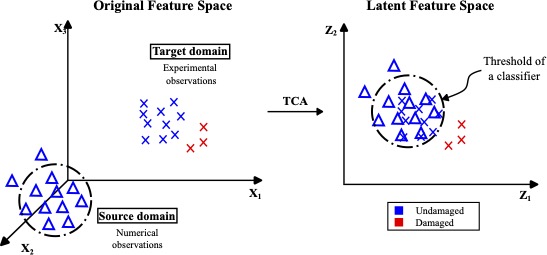
Sensing development
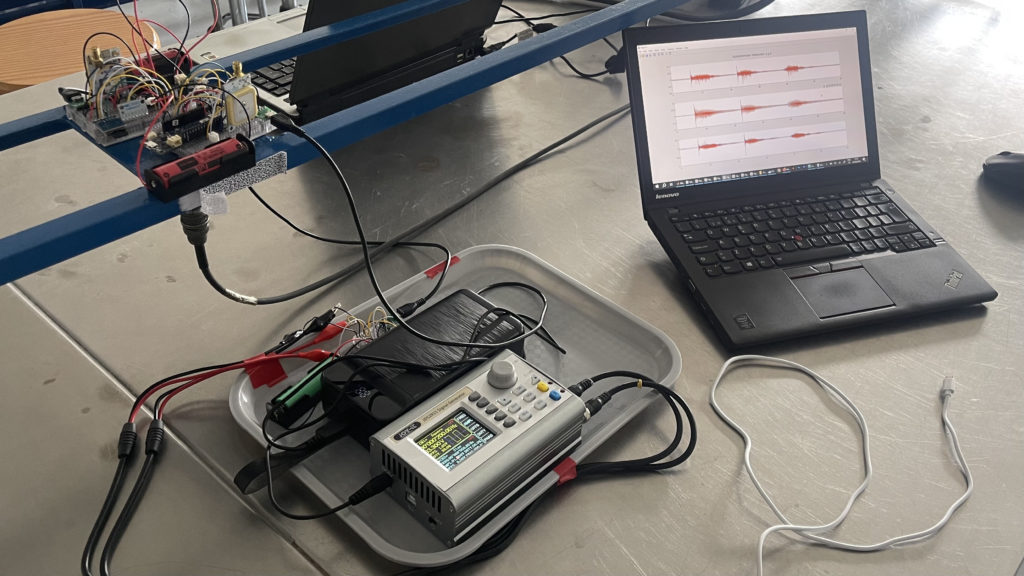 Sensor node development is of utmost importance for SHM, as it allows one to bring data acquisition, feature extraction, and statistical modeling for feature classification together into a common framework.
Sensor node development is of utmost importance for SHM, as it allows one to bring data acquisition, feature extraction, and statistical modeling for feature classification together into a common framework.
In fact, the importance of data acquisition is paramount, given that assessing structural behavior is the first step in damage identification. Moreover, it sets a foundation for properly tailoring physical models to specific structures, and thereby accurately predicting future behavior. Hence, data collection for informed decision making is fundamental when detecting structural damage and degradation, adapting current structures for climate change, or designing new ones that are out-front more resilient and, therefore, more sustainable. To accomplish these objectives, sensor nodes must be able to provide accurate measurements, in a reliable manner, rapidly enough to allow frequency analysis, and with synchronism to enable the tracking of changes throughout the structure. Finally, they must also be cost-effective to make large deployments, and routine assessments possible.
At this point, two sensor types of nodes are in development: (i) Surface temperature and atmospheric temperature nodes, designed for building and bridge installations, that can be synchronized via time server, upload data in real time, and thereby track exterior/interior heat exchanges in buildings and bridges; (ii) Accelerometer nodes designed for ample structure deployment and rapid measurements with synchronization capabilities via GPS signal, and store data locally for later integration.
Recently, bender element development has been pursued as a non-destructive test performed in soil specimens to determine the small-strain shear modulus of the soil.
SHM for climate change adaptation
Climate change has been posed as one of the biggest concerns for the health of bridges. Although the uncertainty associated with the magnitude of the change is large, the fact that our climate is changing is unequivocal. In Figueiredo et al. (2023), the SHM process is proposed as an assessment procedure to evaluate permanently the structural condition of bridges and a warning mechanism to trigger adaptation measures as a function of its predicted vulnerability.
Meanwhile, it is still widely recognized that vibration-based SHM still struggles to produce reliable global information on the presence of damage, mainly because of the effects of operational and environmental variations, like temperature, relative humidity, and traffic. In this context, it is expected that climate change can be another source of environmental variability, especially with changes in temperature. So, what happens if the mean temperature changes over time? Will it significantly affect the dynamics of bridges? Will the reference data set used for the training of algorithms become outdated? Are machine learning algorithms robust enough to deal with those changes? In Figueiredo et al. (2024), we concluded that climate change may be seen as another source of operational and environmental variability to be considered when using machine learning algorithms for long-term damage detection.

SHM to increase Resilience
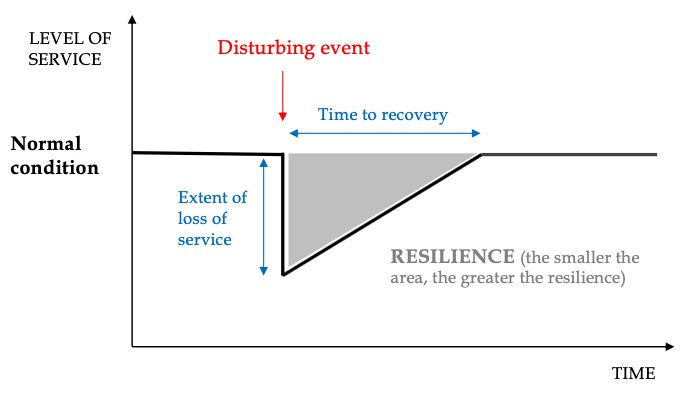
The “resilience triangle” in the figure represents the loss of functionality (or service) from disruption (or damage) and the time for recovery.
SHM increases the resilience of structures as: 1) permanent condition evaluation to guarantee structures can withstand the impacts of extreme events as predicted in the designing phase; 2) rapid structural condition assessment after disruptions caused by extreme events to shorten the time for recovery; 3) continuous structural condition assessment to avoid unnecessary maintenance costs, with consequent benefits of savings for later time recovery; 4) to better understand the condition evolution of existing structures in order to improve the maintenance plan and designing of future structures.
Socially Aware Implementation
The concept of social awareness is implemented to consider different and often conflicting perspectives of stakeholders, users, and legislators over the outcomes of structural health monitoring concerning the maintenance and safety of infrastructure (e.g., bridges).
Main Publications
- Ferreira, L.; Teloli, R.; Silva, S.; Figueiredo, E.; Maia, N.; Cimini Jr, C. (2024). Bayesian data-driven framework for structural health monitoring of composite structures under limited experimental data. Structural Health Monitoring. In Press
- Marasco, G.; Moldovan, I.; Figueiredo, E.; and Chiaia, B. (2024). Unsupervised transfer learning for structural health monitoring of urban pedestrian bridges. Journal of Civil Structural Health Monitoring. https://link.springer.com/article/10.1007/s13349-024-00786-w
- Figueiredo, E., Peres, N., Moldovan, I., Nasr, A. (2024). Impact of climate change on long-term damage detection for structural health monitoring of bridges. Structural Health Monitoring. https://doi.org/10.1177/14759217231224254
- Ferreira, L.; Teloli, R.; Silva, S.; Figueiredo, E.; Moldovan, I.; Maia, N.; Cimini Jr, C. (2024). Bayesian calibration for Lamb wave propagation on a composite plate using a machine learning surrogate model. Mechanical Systems and Signal Processing, 208, 111011. https://doi.org/10.1016/j.ymssp.2023.111011
- Yano, M. O.; Figueiredo, E.; Silva, S.; Cury, A. (2023). Foundations and applicability of transfer learning for structural health monitoring of bridges. Mechanical Systems and Signal Processing, 204.
- Yano, M. O.; Figueiredo, E.; Silva, S.; Cury, A.; Moldovan, I. (2023). Transfer learning for structural health monitoring in bridges that underwent retrofitting. Buildings, 13(9). https://doi.org/10.3390/buildings13092323
- Figueiredo, E.; Santos, L. O.; Moldovan, I.; Kraniotis, D.; Melo, J.; Dias, L.; Coelho, G. (2023). A roadmap for an integrated assessment approach for climate change adaptation of concrete bridges. Journal of Bridge Engineering, 28(6). DOI: 10.1061/JBENF2/BEENG-5735.
- Figueiredo, E.; Yano, M. O.; Silva, S.; Moldovan, I.; Bud, M. (2023). Transfer learning to enhance the damage detection performance in bridges when using numerical models. Journal of Bridge Engineering. 28(1). DOI: 10.1061/(ASCE)BE.1943-5592.0001979.
- Figueiredo, E.; Moldovan, I.; Alves, P.; Rebelo, H.; Souza, L. (2022). Smartphone application for structural health monitoring of bridges. Sensors. 22(21), 8483. https://doi.org/10.3390/s22218483.
- Silva, S.; Figueiredo, E.; Moldovan, I. (2022). Damage detection approach for bridges under temperature effects using Gaussian Process Regression trained with hybrid data. Journal of Bridge Engineering. 27(11), p. 04022107. DOI: 10.1061/(ASCE)BE.1943-5592.0001949.
- Yano, M. O.; Silva, S.; Figueiredo, E.; Villani, L. G. G. (2022). Damage quantification using transfer component analysis combined with Gaussian process regression. Structural Health Monitoring. DOI 10.1177/14759217221094500.
- Figueiredo, E.; Brownjohn, J. (2022). Three decades of statistical pattern recognition paradigm for SHM of bridges. Structural Health Monitoring. 21(6), 3018-3054. DOI 10.1177/14759217221075241.
- Bud, M.; Moldovan, I.; Radu, L.; Nedelcu, M.; Figueiredo, E. (2022). Reliability of probabilistic numerical data for training machine learning algorithms to detect damage in bridges. Structural Control and Health Monitoring. e2950. DOI: 10.1002/stc.2950.
- Silva, M.; Green, A.; Morales, J.; Meyerhofer, P.; Yang, Y.; Figueiredo, E.; Costa, J.; Mascarenas, D. (2022). 3D Structural Vibration Identification from Dynamic Point Clouds. Mechanical Systems and Signal Processing, 166, 108352.
- Qin, S.; Feng, J.; Zhou, Y.L.; Li, C.; Huo, X.; Figueiredo, E.; Yang, F. (2022). Investigation on the dynamic impact factor of a concrete filled steel tube butterfly arch bridge. Engineering Structures, 252, 113614.
- Silva, M.; Santos, A.; Santos, R.; Figueiredo, E.; Costa, J.C.W.A. (2021). Damage-sensitive feature extraction with stacked autoencoders for unsupervised damage detection. Structural Control and Health Monitoring, 28(5), 28:e2714.
- Yano, M.; Villani, L.; Silva, S.; Figueiredo, E. (2021). Autoregressive Model Extrapolation using Cubic Splines for Damage Progression Analysis. Journal of the Brazilian Society of Mechanical Sciences and Engineering, 43(19).
- Paixão, J.; Silva, S.; Figueiredo, E.; Radu, L.; Park, G. (2021). Delamination area quantification in composite structures using Gaussian process regression and AR models. Journal of Vibration and Control, 27(23-24), 2778-2792.
- Silva, M.; Martinez, B.; Figueiredo, E.; Costa, J.; Yang, Y.; Mascarenas, D. (2020). Nonnegative matrix factorization-based blind source separation for full-field and high-resolution modal identification from video. Journal of Sound and Vibration, 487.
- Silva, M.; Figueiredo, E.; Costa, J.C.W.A.; Mascarenas, D. (2020). Spatio-Temporal Decomposition of 2D Travelling Waves from Video Measurements. Mechanical Systems and Signal Processing, 139.
- Figueiredo, E.; Moldovan, I.; Santos, A.; Campos, P; Costa, J.C.W.A. (2019). Finite element-based machine learning approach to detect damage in bridges under operational and environmental variations. Journal of Bridge Engineering, 24(7): 04019061.
- Santos, A., Silva, M., Santos, R., Figueiredo, E., Maia, N., & Costa, J. (2019). Output-only structural damage detection based on transmissibility measurements and kernel principal component analysis. Journal of Communication and Information Systems, 34(1), 64-75.
- Silva, M.; Dreyton, A.; Figueiredo, E.; Reginaldo, F.; Sales, C.; Costa, J. (2019). Deep principal component analysis: an enhanced approach for structural damage identification. Journal of Structural Health Monitoring, 18(5-6), 1444-1463.
- Santos, A.; Figueiredo, E.; Silva, M.; Santos, R.; Sales, C.; Costa, J. (2017). A global expectation-maximization approach based on memetic algorithm for vibration-based structural damage detection. IEEE Transactions on Instrumentation & Measurement, vol. 66(4), pp 661-670. DOI: 10.1109/TIM.2017.2663478.
- Silva, M.; Dreyton, A.; Figueiredo, E.; Reginaldo, F.; Sales, C.; Costa, J. (2017). Agglomerative concentric hypersphere clustering applied to structural damage detection. Mechanical Systems and Signal Processing, vol. 92, 196-212.
- Santos, A.; Figueiredo, E.; Silva, M.; Santos, R.; Sales, C.; Costa, J. (2017). Genetic- based EM algorithm to improve the robustness of Gaussian mixture models for damage detection in bridges. Structural Control and Health Monitoring, vol. 24(3).
- Santos, A.; Figueiredo, E.; Silva, M.; Santos, R.; Sales, C.; Costa, J. (2016). A global expectation-maximization based on memetic swarm optimization for structural damage detection. Structural Health Monitoring, vol. 15(5), 610-625.
- Silva, M.; Dreyton, A.; Figueiredo, E.; Reginaldo, F.; Sales, C.; Costa, J. (2016). A novel unsupervised approach based on a genetic algorithm for structural damage detection in bridges. Engineering Applications of Artificial Intelligence, volume 52, 168-180.
- Santos, A.; Figueiredo, E.; Silva, M.; Sales, C.; Costa, J. (2016). Machine learning algorithms for damage detection: kernel-based approaches. Journal of Sound and Vibration, vol. 363, 584-599.
- Zhou, Y. L.; Figueiredo, E.; Maia, N.; Pereira, R. (2015). Damage Detection and Quantification using Transmissibility Coherence Analysis. Shock and Vibration, vol. 2015, Article ID 290714.
- Zhou, Y. L.; Figueiredo, E.; Maia, N.; Sampaio, R.; Pereira, R. (2015). Damage Detection in structures using a Transmissibility-based Mahalanobis Distance. Structural Control and Health Monitoring, 22: 1209-1222.
- Figueiredo, E.; Radu, L.; Worden, K.; Farrar, C.R. (2014). A Bayesian Approach based on a Markov-chain Monte Carlo Method for Damage Detection under Unknown Sources of Variability. Engineering Structures, 80, 1-10.
- Hernandez-Garcia, MR; Masri, SF; Ghanem, R; Figueiredo, E; Farrar CR (2014). An evaluation of a methodology for detection, localization, and quantification of changes in nonlinear systems based on experimental measurements. Ingegneria Sismica, 31.
- Figueiredo, E.; Cross, E. (2013). Linear Approaches to Modeling Nonlinearities in Long-term Monitoring of Bridges. Journal of Civil Structural Health Monitoring, 3(3), 187-194.
- Figueiredo, E.; Park, G.; Farinholt, K. M.; Farrar, C. R.; Lee, J.-R. (2012). Use of Time-Series Predictive Models for Piezoelectric Active-Sensing in Structural Health Monitoring Applications. Journal of Vibration and Acoustics, 134(4).
- Figueiredo, E.; Park, G.; Farrar, C. R.; Worden, K.; Figueiras, J. (2011). Machine Learning Algorithms for Damage Detection under Operational and Environmental Variability. International Journal of Structural Health Monitoring, 10(6), 559-572.
- Figueiredo, E.; Park, G.; Figueiras, J.; Farrar, C.; Worden, K. (2011). Influence of the Autoregressive Model Order on Damage Detection. Computer-Aided Civil and Infrastructure Engineering, 26(3), 225-238.
- Figueiredo, E.; Todd, M. D.; Farrar, C. R.; Flynn, E. (2010). Autoregressive Modeling with State-space Embedding Vectors for Damage Detection under Operational and Environmental Variability. International Journal of Engineering Science, 48, 822-834.
- Fernandez-Garcia, M. R.; Masri, F. S.; Ghanem, R.; Figueiredo, E.; Farrar, C. R. (2010). A Structural Decomposition Approach for Detecting, Locating, and Quantifying Nonlinearities in Chain-like Systems. Structural Control and Health Monitoring, 17 (7), 761-777.
- Fernandez-Garcia, M. R.; Masri, F. S.; Ghanem, R.; Figueiredo, E.; Farrar, C. R. (2010). An Experimental Study of Change Detection in Uncertain Chain-like Systems. Journal of Sound and Vibration, 329, 2395-2409.
- Taylor, S. G.; Farinholt, K. M.; Flynn, E. B.; Figueiredo, E.; Mascarenas, D. L.; Moro, E. A.; Park, G.; Todd, M. D.; Farrar, C. R. (2009). A Mobile-agent Based Wireless Sensing Network for Structural Monitoring Applications. Measurement Science and Technology, 20(4).

Avenida do Campo Grande,
376 1749-024 Lisboa, Portugal
Tel.: 217 515 500 | email: info@ulusofona.ptPorto
Rua Augusto Rosa,
Nº 24, 4000-098 Porto - Portugal
Tel.: 222 073 230 | email: info@ulusofona.pt
Gestão de conteúdos por Eloi Figueiredo © 2022 COFAC.

